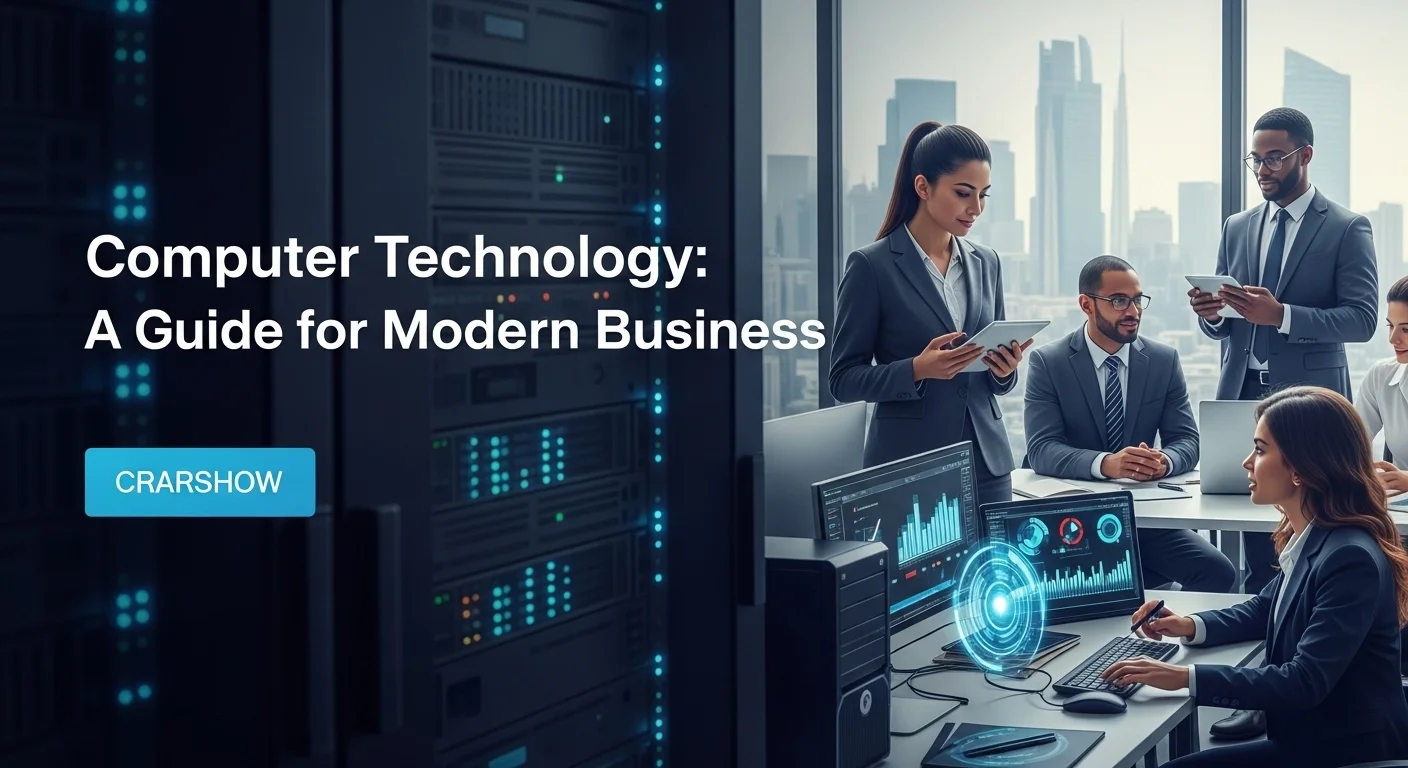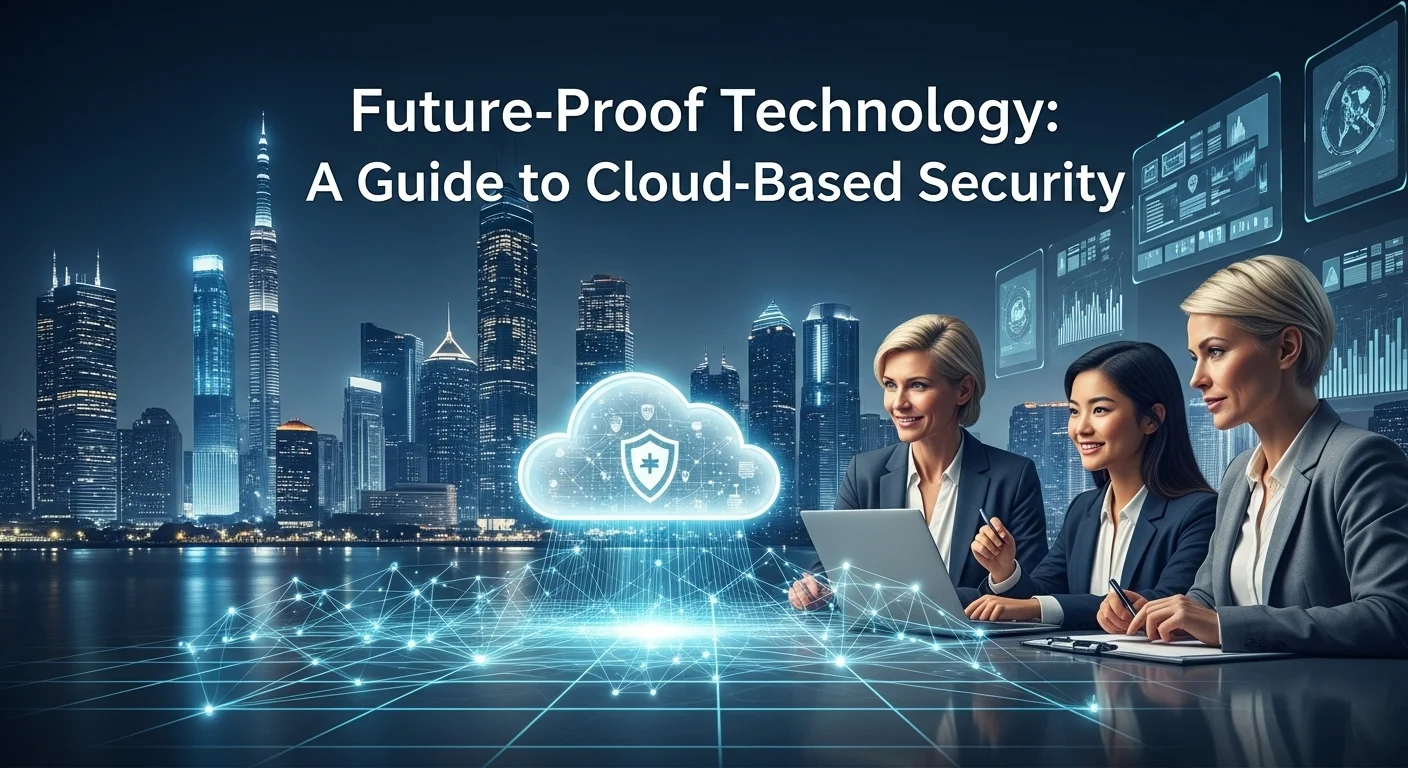Decoding Computer Technology: A Practical Guide for Your Business

Executive Summary
Let's be honest, 'computer technology' can sound intimidating. It feels like a world of complex jargon meant only for IT wizards. But after two decades of helping businesses of all sizes, I've learned that the core ideas are simpler than you think. This guide is my attempt to cut through the noise. We'll explore the essentials, from the software that runs your daily operations to the networks that connect you to the world. We'll even peek into the fascinating future with things like quantum computing from IBM. My goal is to give you, the business leader or curious enthusiast, the confidence to see technology not as a hurdle, but as your most powerful tool for growth and success.
Table of Contents
Table of Contents
- What is a Computer and Its Real Role in Business?
- The Incredible Evolution of Computer Technology
- The Two Pillars: Software and Networks
- Why Good IT Support is Non-Negotiable
- A Deep Dive into Business Software
- Building a Rock-Solid and Secure Network
- The Quantum Frontier: What is It and Should You Care?
- Simple Cybersecurity Habits That Make a Huge Difference
- How to Choose the Right Tech Tools for Your Business
- Finding Quality IT Help When You Need It
- Staying Ahead: How to Prepare for What's Next
What is a Computer and Its Real Role in Business?
When we talk about a 'computer' today, we're not just talking about the box on your desk. It's the smartphone in your pocket, the server in a cooled data center, and the invisible network that connects them all. At its heart, a computer is a machine that follows instructions to manage information. But that simple definition doesn't capture its magic. Its true power is its endless adaptability. It’s a blank canvas that, with the right software, can become anything—a global storefront, a research lab, or a design studio. This is what has made technology the single most transformative force in our lifetime.
For any business, big or small, understanding this is crucial. I've seen companies go from struggling to thriving simply by leveraging technology correctly. The computer is no longer just for accounting in a back room; it's the central nervous system of your entire operation. It manages your inventory, helps you understand your customers, powers your marketing, and lets your team collaborate from anywhere on the planet. In my experience, you don't need to be a coder to lead in this digital age, but you do need to grasp the fundamentals. It's the key to making smarter decisions and staying competitive.
The Incredible Evolution of Computer Technology
The story of the computer is an amazing tale of shrinking size and exploding power. I remember the days of room-sized mainframes that only governments and massive corporations could afford. The invention of the microchip changed everything, leading to the personal computer (PC). Suddenly, this immense power was available to individuals, and it sparked a revolution of creativity. I was there when businesses first started bringing PCs into the office, and the jump in productivity was incredible to witness.
That pace of change has only gotten faster, guided by what's known as Moore's Law. It's why the phone in your pocket today is millions of times more powerful than the computers that sent humanity to the moon. We've moved from desktops to laptops to the cloud, where immense computing power is available to anyone with an internet connection. This has leveled the playing field, allowing startups to innovate right alongside industry giants. And the evolution isn't stopping. On the horizon, we have technologies like the IBM Quantum Computer, which promises to solve problems we once thought were impossible. It’s a constant reminder that this field never stands still.
The Two Pillars: Software and Networks
A computer's hardware is just potential. It’s the computer software that brings it to life. Think of software as the brain and the language of the machine. You have system software, like Windows or macOS, which acts as the foundation, managing all the parts of the computer. Then you have application software, which are the tools you use every day: your web browser, your email client, your accounting program. The harmony between smart hardware and powerful software is what creates a truly useful tool, and it's been the driver of innovation for decades.
But in today's world, a computer on its own is like a person on a desert island. Its real power is unlocked when it connects to a computer network. A network is simply a group of computers linked together to share information and resources. This can be as small as the Wi-Fi in your office (a LAN) or as massive as the internet itself (a WAN). For any modern business, a reliable and secure network is as essential as electricity. It’s the digital plumbing that enables everything from sending an email to accessing cloud services and reaching your customers online. Without it, modern business simply wouldn't exist.
Why Good IT Support is Non-Negotiable
As our reliance on technology has grown, so has the need for good computer help. We've all been there: a critical file is lost, the internet goes down during a big presentation, or a strange error message pops up. When technology fails, business stops. This is where IT support professionals become heroes. They are the mechanics and guardians of your digital infrastructure, responsible for troubleshooting problems, keeping systems running, and protecting you from threats.
I've always told my clients that great IT support isn't a cost; it's an investment in stability and peace of mind. It’s not just about fixing what's broken, but preventing problems from happening in the first place. This includes keeping software updated, monitoring for security risks, and helping employees use their tools effectively. In an age of constant cyber threats and our dependence on always-on systems, having reliable IT support is one of the most important parts of a healthy technology strategy.

Harnessing Technology: A Practical Guide for Your Business
Making sense of the vast world of computer technology is one of the biggest challenges I see business leaders face. To build solutions that actually work and can grow with you, you need a solid grasp of the key pieces: software, networks, and the future trends that are just around the corner. This part of the guide is all about rolling up our sleeves and getting practical. We'll look at how to choose the right software, design a network that won't let you down, and even start thinking about the quantum future. My goal is to help you turn technology from a necessary expense into your greatest asset.
A Deep Dive into Business Software
Software is what turns your business strategy into action. It's the engine of your daily operations. Let's break down the main types you'll encounter:
- Productivity Suites: These are the basics. Think Microsoft 365 or Google Workspace. They are the foundation for communication, document creation, and teamwork. In my opinion, their cloud-based features have single-handedly changed how modern teams collaborate.
- Enterprise Resource Planning (ERP): Don't let the name scare you. An ERP system, like those from SAP or Oracle, aims to connect all the different parts of your business—finance, HR, sales, inventory—into one unified system. A good ERP gives you a bird's-eye view of your entire operation, which is invaluable for making smart decisions.
- Customer Relationship Management (CRM): A CRM, like Salesforce or HubSpot, is your command center for all customer interactions. I've seen businesses transform their sales and service by using a CRM to track leads, manage marketing, and keep customers happy. It’s essential for growth.
- Industry-Specific Tools: Almost every industry has its own specialized software, from design software for architects to patient record systems for doctors. Choosing and managing these tools is a critical task that directly impacts your ability to do your job well.
The biggest shift I've seen recently is the move to Software as a Service (SaaS). Instead of buying software outright, you subscribe to it. This lowers the initial cost and hassle, but it also means you need a good strategy for managing subscriptions and ensuring all these different cloud tools can talk to each other. A key role for any IT support team is to make sure all this software is secure and up-to-date, protecting you from potential risks.
Building a Rock-Solid and Secure Network
Your computer network is the circulatory system of your business. If it's slow, unreliable, or insecure, everything suffers. I always advise my clients to focus on a few key areas when designing their network:
- The Local Network (LAN): This is your internal office network. Fast, wired connections are the backbone, while good Wi-Fi is crucial for mobility. A pro tip is to segment your network with VLANs. This creates separate 'lanes' for different types of traffic, so for example, your guest Wi-Fi is completely isolated from your sensitive financial systems.
- Connecting Locations (WAN): If you have multiple offices, you need a way to connect them. In the past, this meant expensive private lines. Today, technologies like SD-WAN let you use regular, cheaper internet connections in a smart, reliable way, which can save a lot of money.
- Network Security: This has to be a top priority. It's not just about having a firewall anymore. Modern security involves multiple layers, like systems that watch for suspicious activity inside your network and secure VPNs for remote employees. Many businesses are now adopting a 'Zero Trust' model, which is a fancy way of saying 'never trust, always verify' for every user and device.
- Cloud Connection: As you use more cloud services, the connection to them becomes critical. For important applications, a direct, private connection to your cloud provider can offer much better performance and reliability than going over the public internet.
Building and managing a network is a specialized skill. It requires constant monitoring and planning. This is often why businesses turn to Managed Service Providers (MSPs) for computer help. They have the expertise to ensure your network is a strong and secure foundation for everything else you do.
The Quantum Frontier: What is It and Should You Care?
So, let's talk about the future. You might hear the term 'quantum computing' and think it's pure science fiction. For a long time, it was. But it's getting closer to reality, and companies like IBM are leading the charge. Here's the simple version: your computer uses bits, which are either a 0 or a 1. A quantum computer uses 'qubits,' which can be a 0, a 1, or both at the same time. This weird property allows them to process a massive amount of information at once.
Why does this matter? The IBM Quantum Computer and others like it won't be for browsing the web or checking email. They are being designed to solve very specific, incredibly hard problems that would take a normal computer millions of years. Think about designing new medicines by simulating molecules perfectly, creating new financial models, or optimizing global logistics on a scale we can't even imagine.
- Real-world impact: It could revolutionize medicine, finance, and artificial intelligence.
You don't need to be a quantum physicist, but it's smart to be aware of this shift. Visionary companies are already starting to explore how this new form of computing could one day give them an incredible edge. It's a reminder that the world of computer technology is always advancing, and the next great leap forward is already being built.

Tips and Strategies to Master Your Technology
Knowing about technology is one thing; using it effectively is another. I've found that the most successful businesses aren't necessarily the ones with the most expensive gear, but the ones with the smartest habits. This final section is all about practical advice you can use today. We'll cover simple security steps that have a huge impact, how to choose the right tools without getting overwhelmed, and what to do when you need expert help. Think of this as a field guide to getting the most out of your technology investment.
Simple Cybersecurity Habits That Make a Huge Difference
Cybersecurity can feel like a daunting battle, but you'd be surprised how far a few basic practices can go. I tell everyone, from CEOs to new hires, that these are non-negotiable:
- Embrace Multi-Factor Authentication (MFA): If you do only one thing, do this. MFA requires a second code (usually from your phone) after you enter your password. It’s incredibly effective at stopping hackers, even if they've stolen your password. Use it on your email, banking, and any other important account.
- Keep Your Software Updated: Those annoying 'update available' pop-ups are your friend! Hackers love to exploit old, known flaws in software. Setting your programs and apps to update automatically is one of the easiest ways to close those security holes.
- Learn to Spot Phishing: Most cyberattacks start with a deceptive email. Train yourself and your team to be suspicious of unexpected attachments, links that look strange, or emails that create a false sense of urgency. When in doubt, don't click.
- Backup Your Data (and Test It!): Imagine losing all your files tomorrow. A good backup is your only true safety net against ransomware or hardware failure. Use the 3-2-1 rule: 3 copies of your data, on 2 different types of storage, with 1 copy off-site (like in the cloud). Just as importantly, occasionally try to restore a file to make sure your backup is actually working.
- Secure Your Network Basics: For your Wi-Fi, use strong WPA3 encryption and, please, change the default password on your router! For businesses, separating your network into different zones is a smart move to contain any potential breach.
How to Choose the Right Tech Tools for Your Business
The market for computer software is a jungle. It's easy to get lost or sold on flashy features you'll never use. Here’s the approach I recommend to my clients:
- Start with the 'Why': Before looking at any products, clearly define the problem you're solving. What process is inefficient? What goal are you trying to reach? Talk to the people who will actually use the software; their input is priceless for getting buy-in later.
- Think About the Total Cost: The price on the box is just the beginning. Factor in the costs of setup, training your team, and ongoing support. Sometimes a slightly more expensive tool is cheaper in the long run because it's easier to use and better supported.
- Check if it Plays Well with Others: Your business tools need to communicate. Make sure any new software can integrate with the systems you already rely on, like your accounting or marketing platforms. This prevents you from having to do tedious, manual data entry.
- Investigate the Provider: When you buy software, you're starting a relationship. How good is their customer support? Will you get real computer help when you're stuck? For critical tools, you want a stable, reputable company that will be around for the long haul.
- Always Try Before You Buy: I never recommend buying business software without a test drive. Use the free trial period. Get a personalized demo. See how it works with your actual data and workflow. This step alone can save you from a very expensive mistake.
Finding Quality IT Help and Managed Services
Sooner or later, you're going to need expert computer help. The big question for many businesses is whether to hire an in-house IT person or partner with an external company, often called a Managed Service Provider (MSP).
- In-House IT: Having someone on staff means they are dedicated to you and develop a deep understanding of your business. This can be great for larger companies with unique needs, but it's also a significant expense in salary, benefits, and training.
- Managed Service Providers (MSPs): For many small and mid-sized businesses, an MSP is the more practical choice. You get access to a whole team of experts for a predictable monthly fee. They can handle everything from day-to-day help desk questions to complex network monitoring and cybersecurity. When vetting an MSP, look for glowing reviews from businesses like yours.
- What to Look For: A great IT partner is proactive, not just reactive. They should be working to prevent problems, not just waiting for your call. Look for clear Service Level Agreements (SLAs) that outline their promises on response times. For more on this, CompTIA offers excellent resources like their IT Infrastructure Guide, which I often recommend.
Staying Ahead: How to Prepare for What's Next
Technology never sleeps. The key to staying competitive is to cultivate a culture of curiosity and learning. You don't have to be an expert on the IBM Quantum Computer, but being aware that such paradigm shifts are happening is important. Encourage your team to explore new tools. Maybe set aside a small budget for pilot projects in AI or automation. By embracing change instead of fearing it, you ensure that your business and its use of computer technology will continue to grow and thrive for years to come.
Expert Reviews & Testimonials
Jessica Morales, Small Business Owner ⭐⭐⭐⭐⭐
As a small business owner, the section on 'Choosing the Right Business Tools' was a lifesaver. I was overwhelmed by software options, but the TCO and integration tips gave me a clear framework. Thank you!
David Lee, IT Manager ⭐⭐⭐⭐
Solid overview. I appreciated the deep dive into network architecture and the practical mention of Zero Trust. It's refreshing to see an article that gets the technical details right while still being accessible to non-tech colleagues.
Maria Rodriguez, Marketing Director ⭐⭐⭐⭐⭐
This is the best guide on business technology I've read. I finally understand what quantum computing is without my eyes glazing over! The personal, human tone made all the difference. I've already shared it with my entire team.



